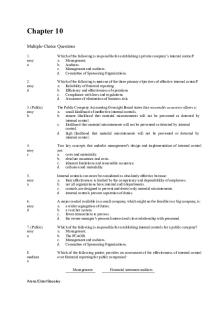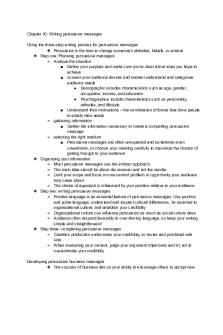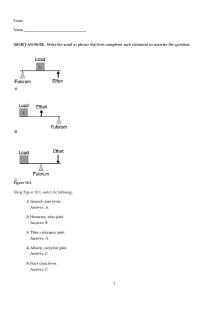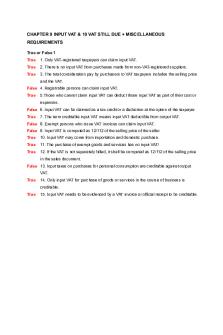Chapter 10 Motivating Employees PDF

| Title | Chapter 10 Motivating Employees |
|---|---|
| Author | Michael Clarity |
| Course | Foundations Of Business II |
| Institution | Drexel University |
| Pages | 6 |
| File Size | 276.4 KB |
| File Type | |
| Total Downloads | 68 |
| Total Views | 151 |
Summary
Chapter 10...
Description
Chapter 10 Motivating Employees
Intrinsic and Extrinsic Rewards Intrinsic Rewards Personal satisfaction you feel when you perform well and complete goals IE.
Pride in your performance Sense of achievement
Extrinsic Rewards Something given as a good recognition of good work IE.
Pay raises Promotions Awards
Taylor’s Scientific Management Scientific Management Studying workers to find the most efficient ways of doing things and then teaching people those techniques Three Key Elements to Increase Productivity 1) Time 2) Methods of work 3) Rules of work Time-Motion Studies Time-Motion Studies Studies of which tasks must be performed to complete a job and the time needed to do each task
Led to the development of the Principle of Motion Economy o Every job can be broken down into a series of elementary motions; developed by Frank and Lillian Gilbreth
Hawthorne Studies: Purpose and Results
Researchers studied worker efficiency under different levels of light Productivity increased regardless of light condition Researchers decided it was a human or psychological factor at play
Hawthorne Effect People act differently when they know they are being studied Maslow’s Theory of Motivation Hierarchy of Needs Theory of motivation based on unmet human needs from basic physiological needs to safety, social and esteem needs to self-actualization needs
Needs that have already been met do not motivate If a need is filled, another higher-level need emerges
Herzberg’s Motivating Factors
Herzberg’s research centered on two questions: o What factors controlled by managers are most effective in increasing work motivations? o How do workers rank job-related factors in order of importance related to motivation
Motivators Job factors that cause employees to be productive and that give satisfaction Hygiene Factors Job factors that cause dissatisfaction if missing but that do not necessarily motivate employees if increased
Theory X and Y
Assumptions of Theory X Managers o Workers dislike work and seek to avoid it o Workers must be forced or threatened with punishment to get them to perform o Workers prefer to be directed and avoid responsibility o Primary motivators are fear and punishment Assumptions of Theory Y Managers o People like work, it’s a part of life o Workers seek goals to which they are committed o Commitment to goals depends on perceived rewards o People can use creativity to solve problems o Intellectual capacity only partially realized o People are motivated by a variety of rewards
Theory Z William Ouchi researched cultural differences between the U.S. (Type A) and Japan (Type J) Type J committed to the organization and group Type A focused on the individual Theory Z is the hybrid approach of Types A and J
Goal-Setting Theory Setting ambitious but attainable goals can motivate workers and improve performance if the goals are accepted, accompanied by feedback, and facilitated by organizational conditions Management by Objectives (MBO) Involves a cycle of discussion, review and evaluation of objectives among top and middle-level managers, supervisors and employees
Managers formulate goals in cooperation with everyone in the organization Need to monitor results and reward achievement
Expectancy Theory in Motivation The amount of effort employees exert on a specific task depends on their expectations of the outcome
Employees ask: o Can I accomplish the task? o What’s my reward? o Is the reward worth the effort? Expectations can vary from person to person
Nadler and Lawler’s Modification 1) 2) 3) 4)
Researchers Nadler and Lawler modified expectancy theory and suggested five steps for managers Determine what rewards employees value Determine workers’ performance standard Make sure performance standards are attainable Tie rewards to performance
5) Be sure employees feel rewards are adequate Using Reinforcement Theory Positive and negative reinforcers motivate a person to behave in certain ways
Positive reinforcement includes praise, pay increases and recognition Negative reinforcement occurs when people work to escape punishment (reprimands, reduced pay, and layoff or firing) Extinction is a way of trying to stop behavior by not responding to it
Equity Theory Employees try to maintain equity between inputs and outputs compared to others in similar positions Workers often base perception of their outcomes on a specific person or group Perceived inequities can lead to reduced quality and productivity, absenteeism, even resignation Enriching Jobs A motivational strategy that emphasizes motivating the worker through the job itself
Based on Herzberg’s motivators, such as responsibility, achievement and recognition
Key Characteristics of work: 1) 2) 3) 4) 5)
Skill variety Task identity Task significance Autonomy Feedback
Types of Job Enrichment Job Enlargement A job enrichment strategy that involves combining a series of tasks into one challenging and interesting assignment Job Rotation A job enrichment strategy that involves moving employees from one job to another Motivating Employees Across the Globe
Cultural differences make worker motivation a challenging task for global managers
High-Context cultures require relationships and group trust before performance Low-Context cultures believe relationship building distracts from tasks A better understanding of cultures helps managers increase customer satisfaction and loyalty o It is more than just knowing other languages, it’s knowing what’s proper
Motivating Across the Generations
Baby Boomers (1946-1964) o Experienced great economic prosperity, job security, optimism about their future Generation X (1965-1980) o Raised in dual-career families, attended day care, feeling of insecurity about jobs Generation Y (1980-1995) o Raised by indulgent parents, used to many comforts like computers and cell phones Generation Z (1996-2009) o Grew up post 9/11, in the wake of the Great Recession and amid many reports of school violence Generation Alpha (after 2010)
Communication Across the Generations Baby Boomers (1946-1964)
Prefer meetings and conference calls
Generation X (1965-1980)
Prefer email and will choose meetings only if there are no other options
Generation Y or Millennials (1980-1995)
Prefer to use technology to communicate, particularly through social media...
Similar Free PDFs

Chapter 10 Motivating Employees
- 6 Pages

Employees Job Satisfaction PPT
- 20 Pages

Study on employees absenteeism
- 64 Pages

Chapter 10 quiz #10
- 3 Pages

Notes 10 - Chapter 10
- 5 Pages

Onboarding New Employees
- 54 Pages

Chapter-10
- 19 Pages

Chapter 10
- 5 Pages

Chapter 10
- 14 Pages

Chapter 10
- 111 Pages

Chapter 10
- 16 Pages
Popular Institutions
- Tinajero National High School - Annex
- Politeknik Caltex Riau
- Yokohama City University
- SGT University
- University of Al-Qadisiyah
- Divine Word College of Vigan
- Techniek College Rotterdam
- Universidade de Santiago
- Universiti Teknologi MARA Cawangan Johor Kampus Pasir Gudang
- Poltekkes Kemenkes Yogyakarta
- Baguio City National High School
- Colegio san marcos
- preparatoria uno
- Centro de Bachillerato Tecnológico Industrial y de Servicios No. 107
- Dalian Maritime University
- Quang Trung Secondary School
- Colegio Tecnológico en Informática
- Corporación Regional de Educación Superior
- Grupo CEDVA
- Dar Al Uloom University
- Centro de Estudios Preuniversitarios de la Universidad Nacional de Ingeniería
- 上智大学
- Aakash International School, Nuna Majara
- San Felipe Neri Catholic School
- Kang Chiao International School - New Taipei City
- Misamis Occidental National High School
- Institución Educativa Escuela Normal Juan Ladrilleros
- Kolehiyo ng Pantukan
- Batanes State College
- Instituto Continental
- Sekolah Menengah Kejuruan Kesehatan Kaltara (Tarakan)
- Colegio de La Inmaculada Concepcion - Cebu




